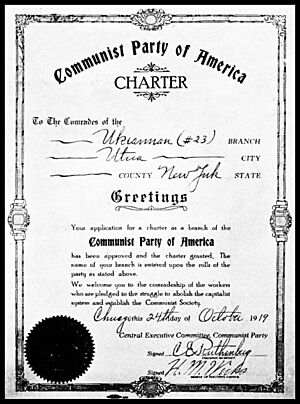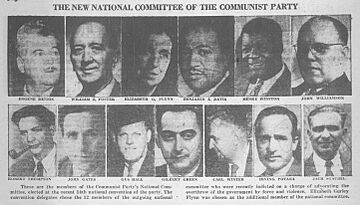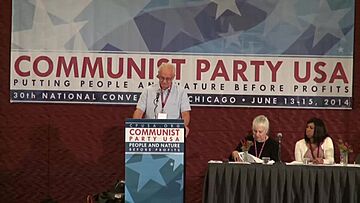Communist Party USA facts for kids
Quick facts for kids
Communist Party of the United States of America
|
|
|---|---|
 |
|
| Presidium | National Convention |
| Co-chairs | Joe Sims Rossana Cambron |
| Founder | C. E. Ruthenberg Alfred Wagenknecht |
| Founded | September 1, 1919 (as the Left Wing Section of the Socialist Party) |
| Merger of | 1921: Communist Party of America Communist Labor Party of America 1922: United Toilers of America 1929: Workers Party of America |
| Split from | Socialist Party of America |
| Headquarters | 235 W 23rd St, New York, New York 10011 |
| Newspaper | People's World |
| Youth wing | Young Communist League |
| Membership | 2024: Peak: 75,338 (December 1947) |
| Ideology | |
| Political position | Far-left |
| International affiliation | IMCWP (since 1998) Comintern (until 1943) |
| Colors | Red |
| Slogan | "People and Planet Before Profits" |
| Party flag | |
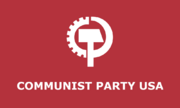 |
|
The Communist Party USA (CPUSA) is a political party in the United States. It was founded in 1919, shortly after the Russian Revolution. The party grew out of the Socialist Party of America and followed the ideas of Marxism–Leninism, a form of communism that was popular in the Soviet Union.
In its early days, the CPUSA faced many challenges. The U.S. government saw the party as a threat, leading to arrests of its members. Despite this, the party grew, especially among factory workers, immigrants, and African Americans. During the Great Depression of the 1930s, the CPUSA became more popular. It helped organize workers into unions and fought against fascism, a political system with a powerful dictator.
The party's membership grew to about 70,000 people in the late 1930s. When World War II began, the party's stance on the war changed. At first, they opposed the U.S. getting involved. But after Germany invaded the Soviet Union in 1941, the CPUSA strongly supported the war effort.
After the war, during the Cold War between the U.S. and the Soviet Union, the CPUSA lost much of its support. The party was investigated for its ties to the Soviet Union, and many of its leaders were put on trial. This period, known as McCarthyism, caused the party's membership to drop to under 10,000 by the mid-1950s.
During the 1960s and 1970s, the party supported the Civil rights movement and opposed the Vietnam War. However, it struggled to attract new members, as many young activists joined other groups. When the Soviet Union broke apart in 1991, the CPUSA faced more difficulties and lost more members.
Today, the CPUSA has changed its focus. It no longer calls for a revolution. Instead, it works within the political system to support workers' rights, racial justice, and environmental protection. The party uses the ideas of Marxism to understand society but focuses on making changes through progressive movements.
Contents
History of the Party
In the first half of the 20th century, the Communist Party was an important part of many social movements. Historians say it was a complex group. It had strong ties to the Soviet Union but was also one of the most active left-wing organizations in America during the 1930s and 40s. It was also the first political party in the U.S. to be fully racially integrated, meaning people of all races could join and participate equally.
Growth During the Great Depression
During the Great Depression, many Americans lost their jobs and homes. The Communist Party was very active in helping the unemployed and fighting for workers' rights. This work attracted many new members. People were also worried about the rise of fascism in countries like Germany and Spain. They admired the Soviet Union for standing up to it. By the end of the 1930s, the party had grown from 7,500 members to 55,000.
Many party members even went to Spain to fight in the Spanish Civil War (1936–1939). They joined the Lincoln Brigade to help defend the Spanish Republic against a fascist uprising.
World War II and Shifting Views
The party's position on World War II was complicated. At first, the CPUSA was strongly against fascism. But in 1939, the Soviet Union signed a non-aggression pact with Nazi Germany. After this, the CPUSA changed its focus from anti-fascism to promoting peace and opposing U.S. involvement in the war.
This changed again in 1941 when Germany broke the pact and invaded the Soviet Union. The CPUSA then became a strong supporter of the U.S. war effort. This period showed how closely the party followed the political direction of the Soviet Union.
The Cold War and Decline
After World War II, the relationship between the United States and the Soviet Union turned into the Cold War. The CPUSA's close ties to the Soviet Union made many Americans suspicious of the party. This led to the Second Red Scare, also known as McCarthyism, a time of intense anti-communist feeling.
The government used the Smith Act, a law against advocating the overthrow of the government, to prosecute party leaders. Many members were arrested, and others left the party out of fear. By 1957, membership had fallen to under 10,000 people. Many of these were secretly informants for the FBI.
The Civil Rights Era and Beyond
The party tried to regain influence by opposing the Vietnam War and supporting the civil rights movement in the 1960s. However, it struggled to connect with the New Left movement of young activists, who often disagreed with the party's strict loyalty to the Soviet Union.
The collapse of the Soviet Union in 1991 was a major blow to the CPUSA. The party lost its main source of international support and funding. This led to a major debate within the party about its future. A group that wanted to move toward social democracy left, and the party became much smaller.
What the Party Believes Today
The CPUSA's ideas have evolved over the years. Today, the party focuses on what it calls "Bill of Rights Socialism," which aims to expand American democracy and freedoms.
A Socialist Bill of Rights
The party believes that socialism in the U.S. should be based on American traditions of democracy. They want to protect the freedoms in the Bill of Rights and add new ones. These new rights would include freedom from unemployment, poverty, and discrimination.
The CPUSA says that under socialism, people would still own their personal property, like homes and cars. The change would be that major industries, like big factories and banks, would be owned by the public instead of by private individuals. This way, the party argues, wealth would be shared more fairly.
Fighting for Workers
A major concern for the CPUSA is the struggle of working people. The party points to problems like unemployment, low wages, and job insecurity as natural results of a capitalist economy, which is driven by profit.
The party believes that workers can improve their lives by fighting for better wages, hours, and working conditions. This "class struggle" can take many forms, from strikes and protests to lobbying for new laws and participating in elections.
Opposing War and Imperialism
The CPUSA is strongly against wars and military interventions led by the United States. The party argues that U.S. foreign policy is often driven by the interests of large corporations, not the American people. They believe that this leads to imperialism, where powerful countries control weaker ones for economic gain.
The party has opposed U.S. involvement in many conflicts, including the wars in Korea, Vietnam, and Iraq. They believe that problems like terrorism cannot be solved through military action and that the U.S. should reduce its military budget and seek peaceful solutions.
Equality for All
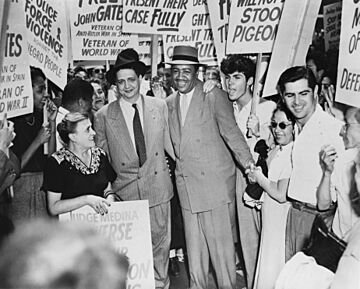
The CPUSA believes the American working class is made up of people of all races, genders, and backgrounds. The party has a long history of fighting for the rights of African Americans and other minority groups. They see racism as a tool used to divide workers and prevent them from uniting to fight for their common interests.
The party also fights for women's rights, including equal pay for equal work. They believe that ending all forms of discrimination is essential for building a fair and just society.
The Party's Relationship with Other Groups
The CPUSA has worked with many different groups throughout its history, especially in the labor movement and peace movements.
The Labor Movement
From its beginning, the CPUSA has been active in the American labor movement. Party members helped organize unions and led major strikes, especially in the 1930s. They played a key role in the creation of the Congress of Industrial Organizations (CIO), a major federation of unions.
The Peace Movement
The party has been a consistent voice in the American peace movement. It opposed U.S. involvement in World War II before the Soviet Union was invaded, and later opposed the wars in Korea and Vietnam. More recently, the party was active in protests against the war in Iraq.
Notable People in the Party
Over the years, many well-known activists, artists, and leaders have been members of or worked with the CPUSA.
- Angela Davis: A famous activist and professor who was a member from 1969 to 1991. She ran for Vice President on the party's ticket.
- W. E. B. Du Bois: A leading African American intellectual and co-founder of the NAACP, who joined the party late in his life.
- Paul Robeson: A world-famous singer, actor, and activist who was a strong supporter of the party's goals.
- Gus Hall: The party's leader for over 40 years, from 1959 to 2000. He ran for president four times.
- Elizabeth Gurley Flynn: A labor leader and activist who became the first female chair of the party in 1961.
Images for kids
-
New York City Councilmen Peter V. Cacchione and Benjamin J. Davis Jr., two of the only elected officials of the Communist Party, served during and after World War II.
-
May Day parade with banners and flags in New York.
See also
 In Spanish: Partido Comunista de los Estados Unidos para niños
In Spanish: Partido Comunista de los Estados Unidos para niños


